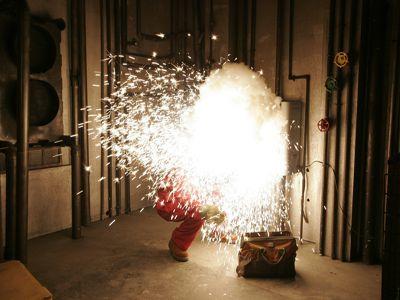It’s not easy finding effective safety equipment, especially if you are a woman. I’ve done a little research to see what’s out there and came up with some good options for general safety-wear, but I was completely stumped by a question the other day on the Women in HVACR Facebook Page regarding Arc Flash Safety.

Anyone who has done field work has probably gotten zapped at one time or another, lower voltages like 24v feels a little like a buzz, 120v is a pretty good zing. I’m told that 208v is more than a little unpleasant (haven’t experienced it myself, thankfully!).
Arc flash is an entirely different animal. More akin to a lightning bolt, it can involve extremely high temperatures and a high probability of death or at least serious injury without proper protection. I won’t go into gory details, but I saw some photographs of the aftermath of high voltage arc flash incidents and I had nightmares for a week.
So obviously, safety is a primary concern when dealing with arc flash. To start, you want to avoid wearing metal (duh) and any synthetic materials (because synthetic materials melt at high temps, meaning your clothing would basically melt onto your flesh, which I think we can all agree, is not desireable). So, no metal and no synthetics…sounds simple, right? Sure, until you think about a woman’s bra. A bra with no metal and no synthetics like plastic, elastic, velcro, spandex, etc.? Good luck with that!
So when the question was posed of where to find a bra that meets those requirements for arc flash safety, I emailed a couple safety companies who cater specifically to women. All I got was dead air, crickets chirping and complete unresponsiveness. Not cool safety peeps. Not cool. The best Google could offer was a 100% cotton pull-on bra that fit up to a B cup. Basically a glorified handkerchief offering zero support. Not exactly a solution for a lady who needs to get stuff done in the field.

So other than going “commando” which was suggested semi-facetiously, I think, I was totally out of options for a well-endowed lady tech. Fortunately, an experienced female field tech chimed in to save the day by offering advice, which I appreciated immensely and will pass along here.
Disclaimer: Please keep in mind that to my knowledge, neither she nor I, is an OSHA-certified safety professional. I enthusiastically welcome anyone who is to suggest a source for qualifying undergarments and other safe alternatives.
Here is what she had to say:
100% cotton coveralls, are what I use, generally a sports bra, and no I don’t worry about the elastic, the concern is not over conductivity of the spandex or elastics, but rather the flammability of these materials should there be an arc flash. Wearing the coveralls when working with high voltages, gives you the added protective layer. Empty your pockets, ring, watches, wallet and keys, all into your tool box/bag, (so) they stay in your possession and out of your way. Duluth Trading Company and Carhart both make women’s work jeans that will take the heat from steam, and have very low spandex/nylons, 90 + % denim. Also Dickies for women, I like slacks with the double knee, though they are durable they are a higher blend.
-Christine B., Brooksville, FL
Another source said that as long as the bra is not underwire and does not have any other metal fastenings in the FRONT, it’s acceptable to wear underneath proper protective clothing (such as 100% cotton coveralls and other appropriate PPE).
I’m no expert, but as far as I know, men’s undergarments are also pretty universally elasticized so they don’t fall down – well, maybe not the plumbers’ – so I would imagine that these tips are acceptable safety practices. Does anyone else out there have any other suggestions? Best practices? C’mon, help a girl out!
